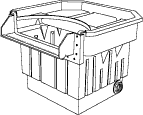 General Information
General InformationGreen Roofs
Rainwater Harvesting
Ponds and Wetlands
Systems
Lily Pond
Rock Pond
Formal Pond
Koi Pond
Marsh Pond
Fountain Pond
Still Pond
Pondless Watercourse
Liners
Filters
Pumps
Plumbing
Fountains
Water Quality
Other Products
Documents
Energy-Efficient Building
Waterproofing

A ROCK POND
When water flows over the earth, it strips the soil, exposes the rocks and gravel below, and creates waterfalls. A rock pond attempts to recreate this natural landscape, although on a much smaller scale. For the most realistic appearance, the design should be integrated into an existing hillside, and the surrounding site should be covered with rocks similar to those used in the pond. Since the water should be fast-flowing, marginal plants are more appropriate than floating plants. The fish population should not exceed one inch of fish per square foot of pond surface. A depth of 18" to 24" is sufficient, except in cold climates.
In the illustration, the pond is excavated as a series of terraces. Protection fabric is laid over the soil and covered with a rubber pond liner. Rounded rocks form the edge of each terrace, while the horizontal surfaces are covered with coarse river gravel that completely conceals the rubber liner. Water is drawn into a skimmer (left) which extracts leaves and other floating debris. A submersible pump at the rear of the skimmer conveys the water underground into the bottom of a waterfall filter (right). As the water rises, it is mechanically and biologically filtered by various filter media. Reaching the top, the water spills over a flat rock set on the lip of the filter, beginning the waterfall.

ROCK POND KITS: We can custom design a complete kit with everything required to build a rock pond of any size and shape. Typical components are shown below: click on an image or title for more information. After construction has been completed, we can also ship a package of appropriate plants.
|
|
|
|
||
|









